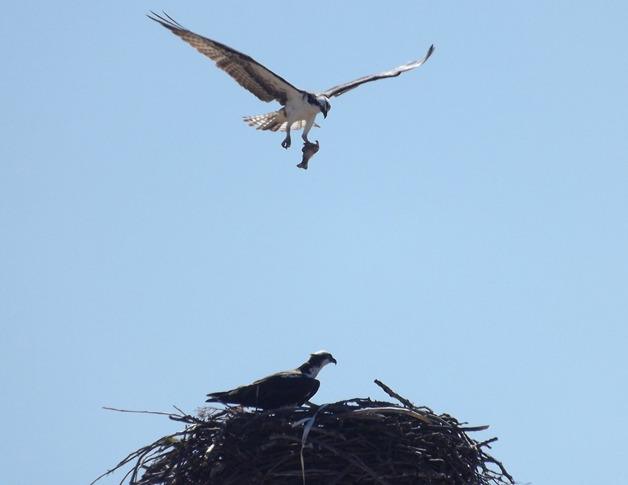When osprey return to Whidbey Island from the south this spring they’ll find a few changes in their homes.
Some will be gone, some were moved, and some must be rebuilt starting from scratch.
Osprey nests are visible from several places along Highway 525, particularly between Freeland and Greenbank, and motorists get possessive of the birds of prey. They watch the adults feed the young as they hungrily poke their heads above the nest, and if they’re really lucky, the can see the young take wing for the first time, daringly leaping off a nest 100 feet or more above the ground. 
The fish-eating raptors don’t know it, but their nests are well taken care of during the winter months by a Puget Sound Energy (PSE) expert who keeps the supportive Whidbey Audubon Society apprised of his efforts.
Passersby may have noticed the nest south of Greenbank was recently removed to allow a cell tower company to do repairs. But don’t be surprised to see it rebuilt this spring. Mel Walters, the PSE biologist, spoke to Whidbey Audubon last month and said the osprey will be allowed to build a new nest on that same site.
Audubon member Robin Llewellyn, a Greenbank resident, actually rode in a cherry picker as cell tower work was done atop a power pole on Race Road on Central Whidbey.
“It works so well to have a company that’s of the same mindset as environmental people,” she said, referring to PSE. “These birds would not have a place to nest without the support of these companies, there are not enough old growth trees left.”
She described here ascent in the cherry picker by saying, “Oh, my gosh, it was a thrill! I’ll never forget it. I felt like a little kid going up on a wonderful ride.”
At 96-feet, she found herself holding onto the edge of the nest and enjoying the bird’s eye view of the surroundings. An old, aromatic, osprey egg was found beneath the litter of limbs that comprised the nest.
“When they tore it down they ran across the egg, it didn’t hatch, but it had to go to the U.S. Fish & Wildlife guy who took the egg. It was a couple of years old,” she said.
At this particular site, according to information from Whidbey Audubon, in 2010 PSE built a nesting platform near the pole shared with a cell phone company. The osprey accepted the platform at first, but then reverted to the cell tower. Therefore, on Feb. 26, Northwest Utility Services, contracted by Verizon, destroyed the nest on the cell tower, set up deterrents for future nesting and reinforced the nearby platform pole to make it more attractive for nesting. 
The osprey nesting season on Whidbey Island begins in April, so any changes to nests must be completed well before then. March 1 was the deadline for nest changes.
Walters told The Record on Wednesday ospreys like to nest atop power poles with cellular platforms. PSE leases the space to cell companies but they are not allowed to touch osprey nests without PSE oversight.
“Usually when PSE has a situation where a nest is in danger due to wires and fires I move the nest,” he said.
Fires can be sparked by the power lines themselves or by electronics in the cell platforms. In the Greenbank case the nest was allowed to be removed, with state removal, for major work on the cell platform.
“We essentially destroyed the nest during the non-breeding season, but this is not the usual thing,” Walters said. “Normally I move the nests.”
Ospreys are by nature adaptive to nest changes. They fly south to Arizona and Mexico in the fall, and nests built in trees or on snags often blow down. “They come back and rebuild their nest in the same location or nesting territory,” he said. “There’s really no issue with having an osprey nest removed during the non-breeding season.”
Still, he realizes people miss the nests and sometimes complain. “They take ownership of that bird, it’s their nest, their bird,” he said. “When a location changes they react in the wrong way.”
Locations don’t often change, however, as Walters said he moves only four or five nests a year in his nine-county region. “I get why some people get upset, but the birds are going to do fine,” he said.
The osprey population has increased rapidly in this state since the chemical DDT was banned. In 1975 they were on the endangered species list; today their numbers are high and they can be bothersome.
“Osprey nests are a huge problem for me,” Walters admitted. “They get into conductors, catch on fire, the birds can be killed.” His goal is to protect the facilities while protecting the birds, preferably without moving the nest.
Alternative nesting sites aren’t always accepted by the ospreys. “Birds do what they want to do, they’re like kids,” he said. To help, PSE encourages cell companies to place deterrents to prevent birds from nesting on their structures. Deterrents include bird guards, flashers, spinners and a new type of avian-safe line.
Only time will tell how these particular ospreys will react to the changes to their nests near Greenbank and on Race Road.
“I told the Audubon Society on Valentine’s Day the birds will likely come back,” Walters said. “We’ll know in a couple of weeks.”


